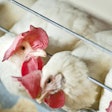
Very carefully consider each line of raw materials in a formula before sending it to production.
Sustainability means different things to different people and organizations. For some, it is about preserving or even improving the planet, which we must pass on to future generations. For others, it can mean they do more with less (recycle, reuse, reduce). It is a hot topic of discussion, and the animal feed industry is actively involved to participate in this development.
Happily, to my understanding, the animal feed industry is taking a proactive stance, perhaps having learned from bitter lessons of the past. But we are still looking for what is best and, above all, who must pay the bill in the end.
I can offer the following six points of consideration that I have penned down as the ones most frequently coming up in my discussions with interested parties.
-
Country of origin
The most striking example here is soybean meal, and the deal between one group of importing countries and a mega-producing country regarding the need to ensure soybean meal is not produced at the expense of deforestation. Another example, less obvious, has to do with digestibility of soybean meal, which is known to differ depending on country of origin. As we will see below, digestibility is part of sustainability, and not just a measurement of wasted money and nutrients.
A final example is that of amino acids that must be imported to feed animals that are raised next to fields of soybeans. A recent life-cycle analysis (LCA) showed that such feed-grade amino acids are not as environmentally neutral as we believed. But that was just one review, and we definitely need more work on this subject.
-
Digestibility or TDN
Digestibility measures what is actually taken up by the animal, assuming 100% absorption efficiency. The rest of what we feed to our animals daily goes back to nature, where it can be used efficiently to fertilize poor soils or inefficiently when not disposed properly.
The latter contributes to environmental pollution. Thus, using feeds with high digestibility is the right thing to do, at least from the point of view of sustainability. In such case, then the old index measurement total digestible nutrients – which is widely available for most ingredients in many old textbooks – should be resurrected and be given a new role to play.
-
Wasted additives
In my commercial experience, I can attest there is an overuse of additives, which goes down when prices are not favorable and up when broiler prices increase. The same happens in other species too, so it is a wider practice.
If we consider that each additive is produced by a mega-factory that is 10,000 miles away and needs to be transported, stored and delivered to our door, then perhaps we do not really need it after all. This is especially true for additives we add for marketing purposes or without much thinking or testing, simply because they do not add that much to final feed cost.
I have reviewed countless formulas in my work, and I keep slashing superfluous additives with impunity, especially those which nobody remembers why they were added in the first place. I recall a colleague that, when he started working with a new customer, he used to remove all additives from a formula and started adding them back one by one only after thorough testing. I prefer the middle way: keeping only those that I believe fit with the formula and the goals of the customer.
-
Soy or amino acids
If you are in Iowa next to a soy crushing plant and you buy amino acids from across the Pacific, then it would be hard to believe this is the sustainable thing to do – especially if the manure goes back to your own soy fields. The opposite is quite true for the other side of the ocean. There are of course more aspects to consider, but you should go neither too low nor too high on natural proteins before the overall framework of operations is considered.
For example, excess protein will increase water intake, which might lead to wet-litter problems. But, the same can happen by excess ash – something we keep forgetting. On the other hand, without enough natural proteins, animals might not be able to synthesize the non-essential amino acids, leading to impaired performance. There is always a golden balance that suits each individual farm, but not one that suits all farms all the time. So, guideline are just that, guidelines, and not a roadmap.
-
Ash and water intake
We just mentioned this, but it merits repetition if only because not many realize that adding all kinds of additives (that often have an inorganic carrier/filler) increases total ash (minerals). Most minerals ingested in excess need to be excreted through urine, which requires water. This leads to increased water consumption and excretion, and the end result is wet litter and problems associated with it.
A wet littler aids nitrogen in manure to escape as nitrous. One molecule of nitrous oxide (N2O) contributes as much as 265 times to climate change as a single molecule of carbon dioxide (CO2). Not to mention that saving water should be a priority for all.
-
Excess vitamins and trace minerals
We routinely add up to 100 times the amounts of certain vitamins and/or minerals. We do this as a safety measure because some vitamins (especially) are too sensitive (vitamin C for example is virtually lost by the time it reaches the feeder if not protected). Or, we use such excessive margins because the old adage said “vitamins and trace minerals” make up less than 2% of total feed cost. I think today they cost more, but we still feed too much of them. And, with modern minerals with high(er) bioavailability, we do not consider reducing dietary specifications, for obvious reasons.
All that would not be a major problem if most vitamins and trace minerals did not have to come across the globe after being manufactured in mega-factories that often do not have to follow any environmental regulations. Again, wastage, inefficiency, and lack of environmental responsibility.
In closing, my only recommendation is to consider very carefully each line of raw materials in a formula before sending it to production. Do you need this raw material? Can you replace it with something more sustainable without increasing cost? Can you remove something else that is not needed as much to make room for the other more expensive alternative?
Sustainability starts at the computer, and there are things we can do without increasing cost in order to be able to claim our feed is more sustainable than it used to be.















